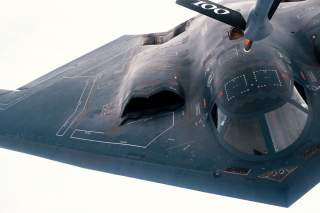Can Russia's S-500 Really Kill an F-22, F-35 or B-2 Stealth Bomber?
Let's check it out.
What is definitively known about the S-500 is that it is of very high priority to Russian president Vladimir Putin and that it presented publicly as primarily a high-altitude defense system.
Russia’s fearsome new S-500 air and missile defense system has apparently entered production—and is setting new records for missile engagement range.
(This first appeared last month.)
The next generation weapon is designed to supplement Moscow’s already potent S-400 and replace the A-135 anti-ballistic missile system. Not only does the weapon have unprecedented capability to hit high altitude targets—including ballistic missiles and satellites—at extremely long ranges, there have been some claims—usually from the media—that the system could target stealth aircraft. However, while some analysts believe that might be theoretically possible, there has been nothing to substantiate that claim.
What is definitively known about the S-500 is that it is of very high priority to Russian president Vladimir Putin and that it presented publicly as primarily a high-altitude defense system. "It is necessary to develop and build up technological groundwork in the area of air defense, to continue modernization of Pantsir systems, to finish the development and preparations for mass production of the S-500 newest systems capable of hitting targets at super-high altitudes, including near-the-earth space," Putin said in May.
Recommended: Air War: Stealth F-22 Raptor vs. F-14 Tomcat (That Iran Still Flies)
Recommended: A New Report Reveals Why There Won't Be Any 'New' F-22 Raptors
Recommended: How an ‘Old’ F-15 Might Kill Russia’s New Stealth Fighter
While not all aspects of the S-500’s capabilities have been known to have been demonstrated by the West, there is little reason to doubt the capabilities of Russian air defense systems. Indeed, according to U.S. defense sources, Moscow recently conducted a record-breaking test of the S-500 system at ranges that were previously thought to be impossible. According to a CNBC report citing U.S. intelligence officials, “the S-500 surface-to-air missile system successfully struck a target 299 miles away, which the U.S. assessed is 50 miles further than any known test.”
The CNBC report suggests that the missile used to hit the target was a version of S-300V4’s long-range heavy NPO Novator 9M82MD missile, which has a range of 250 nautical miles and a speed of about Mach 7.5 (It also has light missile with a range of 80 nautical miles). However, it is more likely that the missile in question is a derivative of the 250 nautical mile range 40N6 missile used on the S-400—which has been reported in the Russian media. In either case, the fact remains that the S-500 has demonstrated exceptional capabilities.
As Vladimir Karnozov at Aviation International News reported earlier this year, the S-500 uses several types of missiles. When used against air breathing targets, the S-500 can use the 48N6 family of missiles, which weight about two tons and have an effective range of up to 130 nm (240 kilometers). For longer-range targets, Karnozov reports that the system uses version of the 40N6 with higher performance. It also employ the shorter range and lighter weight 9M96 and 9M100 family missiles, which weigh 530 pounds (240 kg) and upwards.
Against ballistic missile threats—and apparently with a secondary capability against air targets—the S-500 uses the 77N6-N and 77N6-N1 kinetic kill missiles. The missiles are capable of hitting their targets at 7 kilometers per second, which the Russians expect would be sufficient to destroy any incoming aerial target including satellites. It apparently has the capability to engage targets as high as 124 miles—or 200 km or 656,000 feet— at ranges of 324 nautical miles or 600km. It can engage as many as 10 incoming ballistic missiles simultaneously and has a response of less than 4 seconds.
There are some reports that the S-500 can engage stealth aircraft including the Lockheed Martin F-22 Raptor, F-35 Joint Strike Fighter or any other low observable platform for that matter. The Russians claim that the system can engage over the horizon and can be plugged into an air defense network—to include satellites.
"It is safe to say already now that Russia has created the world's first multi-stage air defense system, that will reliably protect the country from massive missile strikes," Zvezda TV station stated. "The S-500 will analyze information about a possible missile attack obtained by early warning satellites and over-the-horizon radars, such as the Voronezh, as well as select targets, in terms of their importance, cut off false targets at a great distance, accompany all this and finally issue target designations to various systems."
Given the S-500’s advanced networking capabilities, some military analysts have suggested that the Russians might genuinely be able to engage stealth aircraft. Indeed, by networking multiple high-speed long wave radars such as the RLS Voronezh-DM and 1L119 Nebo SVU, it might be possible to generate a weapons quality track on an aircraft such as the F-22 or F-35. Sensor fusion has afforded militaries many capabilities that are greater than the sum of their part. This many be one such case.
Image: DVIDShub.

